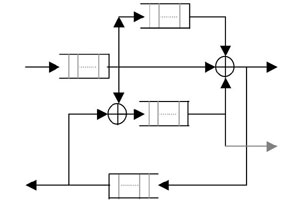Input Specifications for Queueing Networks :
For networks of queues, one must typically provide additional information, such as -
• Interconnections between the queues
• Routing Strategy - deterministic, class based or probabilistic with given routing probabilities
• Strategy followed to handle blocking if the destination queue is one of finite capacity (i.e. with finite number of waiting positions)
Interconnections between the queues essentially decide the next queue that a job can possibly join once service at the current queue has been completed. Where the job can go to more than one such destination queue, we need to additionally provide information on how this routing will be done. This Routing Strategy can be deteminsitic, random with different routing probabilities or class based. If the destination queue has a finite capacity (i.e. a finite number of waiting positions) then incoming jobs to it may be blocked because all the waiting positions are occupied. In that case, we need to additionally specify what to do if such blocking is encountered (e.g., one can discard the blocked job or make it wait at the source queue until a waiting position for it can be found in the destination queue.)
Types of Queueing Networks - Open and Closed :

Open Queueing Network :
 |
In an open queueing network, customers enter the system from outside and after service at one or more queues, eventually leave the system.